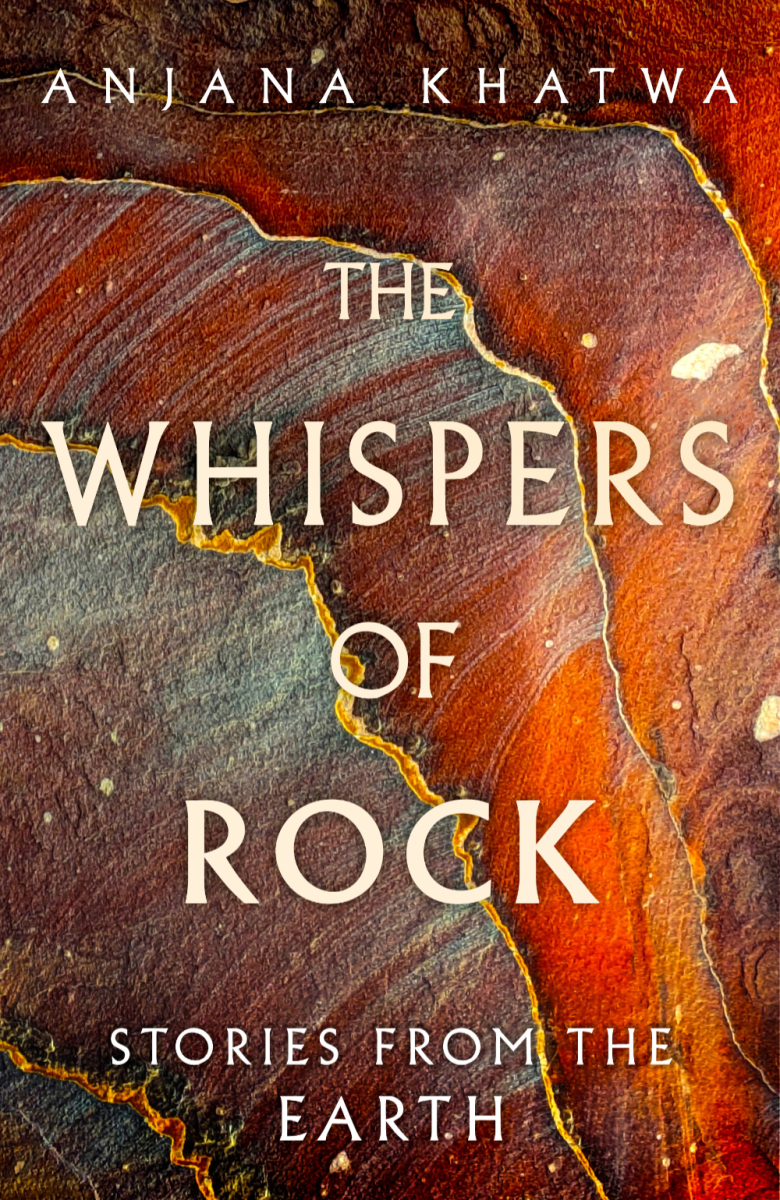I can walk through the world and travel back in time whenever I want. I can enter worlds that no longer exist to feel an ancient wind that once moved a sand grain or gain a sense of how a river once flowed across the land. To do this I only need to do one thing – to reach out and touch a rock.
My new book, The Whispers of Rock: Stories from the Earth is written to help people enter this world which I have loved since I was a child – much like you. I grew up in Slough and fell in love with science after a school trip to the Science Museum in London. I dreamt of becoming an astronaut but it was on a holiday to see my extended family in Kenya where my ambition changed. We stopped off at the Shetani lava flows in Tsavo West National Park in southern Kenya, and as I walked over the jagged black rocks I was captivated by the stories they were whispering to me. They spoke of rivers of lava flowing over the land, and in the stillness of time how that molten mass hardened into rock. I picked up a fragment of the basalt and took it home as a memory of that day. Over the years I knew this was what I wanted to do – to become a storyteller of rocks. But my parents were less sure and over the years I had to work hard to convince them that this was my pathway in life. I went back to see those rocks in Kenya two years ago and as I touched them I felt a circle was complete. The stories they had revealed to me was now going to become a book that I could share with the world.
When I look at rocks, I can tell their stories through colour, pattern, texture and form. A granite tells me about invasion – how a semi-molten mass of magma tried to break through the earth’s crust but got inadvertently trapped on the way. The crystals that sparkle in the rock speak to me about patience; for it is over millions of years where the minerals separate out and eventually grow like flowers in a meadow that gives granite its unique character. Other rocks like sandstones are sometimes criss-crossed with arcuate lines of grains. When I lived in Utah, these were some of my favourite rocks to see because as I ran my fingers along the crossbedding structures, I could feel the breath of an ancient wind rolling a sand grain along the surface of a dune. That same wind caresses my face today and these simple moments connect me to the deep past.
Science is one way of understanding how our world was created, but it is important to realise that millions of people also see landscapes and rocks through a more spiritual lens. In southern Utah, First Nations (the Indigenous peoples of North America) see natural rock bridges and arches as portals to another world. Geologically, these features were formed by the wind and water whittling away at weak points in the rock to create large openings that would eventually become arches and bridges. Tribal leaders will remain close to the bridges and arches for days at a time, looking at them and communing with them. These experiences are called Vision Quests and through being close to the rocks and focusing on what they can learn from them; tribal Leaders bring that knowledge back to their communities. This is what we do as geologists – we also connect ourselves with the rock and try to tell their stories so we can help people navigate the world in an informed way.
Alongside this link between spiritualities and science, I was also surprised by how rock continues to shape our lives. In the middle ages, bakers used to add a mixture of ground up chalk, bones and alum to whiten bread that had become increasingly popular in society. But this combination made people, and especially children very ill leading to malnutrition and in some cases death. Today the bread we eat is much safer but it still contains additives of food grade calcium carbonate which is sourced from crushed marble imported from Italy. In another story, I learnt from a Kenyan coffee farmer how the pH of the soil can affect the flavour of coffee. The benefit of living in volcanically active regions are incredibly fertile soils that form from the lava and ash ejected during eruptions. Stratovolcanoes (such as those in Colombia and Peru) erupt rhyolitic lava that eventually hardens into rhyolite to weather down into acidic soils. Coffee grown in these regions are lighter in colour and have a more citrus flavour. Basaltic lavas that erupt from shield volcanoes (such as in Hawaii or Kenya) are richer in alkaline and produce a sweeter, mellow tasting coffee.
The theme of ‘One Earth, Many Stories’ for International Geodiversity Day 2025 couldn’t have come at a better time for me, as this is a golden thread that runs through my book. If we see rocks as part of our living world, with a right to exist just like a tree or an animal, suddenly it feels harder to exploit them. Rock is a finite resource taking hundreds of millions of years to form and once taken from source, modified or destroyed its inherent story in the landscape is lost forever. Through embracing ancient wisdom of Indigenous and global majority cultures, we have the potential to open doors to building a sense of custodianship with rock. In the past, our ancestors only used what was necessary and if we return to these same values, we have a chance to deliver the UN Sustainable Development Goals such as responsible consumption and production, sustainable cities and communities which in turn will lead to increasing life chances for people across the world. You can be an advocate for geodiversity by helping your friends and family to understand that rocks are an important part of our natural world. They support living ecosystems, provide us with minerals that sustain the way we live but more than that – they are ancient storykeepers of our world and our lives.
I bring rocks to life by telling scientific stories in a way that captures people’s hearts and minds. In my book, I have written special moments where the rock has a chance to tell its own story or we have a conversation where it reveals how it truly feels. Some rocks feel sad that they have been abandoned and abused by people (like coal) and others feel grateful to be found and not lost to be destroyed as part of the rock cycle (an Ichthyosaur vertebra I found on Lyme Regis beach). This combination of science and poetry brings new life to rocks – it gives them spirit and meaning which for too long we have not felt or noticed. Perhaps one of the most stunning places I visited to conduct research for the book was Petra Archaeological Site in Jordan. The 500 million year old multicoloured sandstones were captivating. Their whispers told of ancient rivers that danced across the land, carrying sand grains as they went and I could see each one as my fingers traced lines across the rock face.
If I could take you on a trip to listen to the whispers of rock, it would be to the slate spoil tips by Penrhyn Quarry in North Wales. Here the rocks feel desolate and sad at first because they made way for the slate that was used to tile factories for the industrial revolution. But if you look closer you will see how nature is reclaiming the rocks for her own again. The rocks which once whispered of distress and failure now sing of renewal and belonging. It is a magical place that helps us understand that even if we harm the earth through extracting what we need, nature will always find a way to recover. If you are inspired by my story and want a career as a storyteller of rocks, my advice is always to stay curious and deeply feel the world around you. Listen and learn from different voices such as artists, scientists, poets and elders in your community. For once you learn how to listen to the whispers of rock, they will never leave you.
More About Anjana
Dr Anjana Khatwa is an earth scientist who loves rocks, fossils and the amazing stories they tell us about our planet. She has worked with the Jurassic Coast World Heritage Site, the National Trust, and even appeared on TV to share her passion for nature and science. Anjana has won lots of special awards for helping people discover and enjoy the wonders of the Earth. She lives in Dorset with her family, in a house full of rocks and fossils collected from all around the world. The Whispers of Rock is her very first book!
The hardback version of The Whispers of Rock is available from all good book shops and there’s an audio version available too.
More about International Geodiversity Day
👉 Find out more about International Geodiversity Day
👉 Watch our Interview with Dr Anjana Khatwa on our YouTube channel


